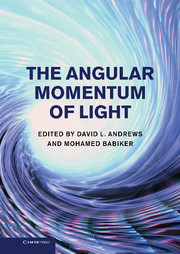Book contents
- Frontmatter
- Contents
- List of contributors
- Preface
- 1 Light beams carrying orbital angular momentum
- 2 Vortex transformations and vortex dynamics in optical fields
- 3 Vector beams in free space
- 4 Optical beams with orbital angular momentum in nonlinear media
- 5 Ray optics, wave optics and quantum mechanics
- 6 Quantum formulation of angle and orbital angular momentum
- 7 Dynamical rotational frequency shift
- 8 Spin-orbit interactions of light in isotropic media
- 9 Quantum electrodynamics, angular momentum and chirality
- 10 Trapping of charged particles by Bessel beams
- 11 Theory of atoms in twisted light
- 12 An experimentalist's introduction to orbital angular momentum for quantum optics
- 13 Measurement of light's orbital angular momentum
- 14 Efficient generation of optical twisters using helico-conical beams
- 15 Self-similar modes of coherent diffusion with orbital angular momentum
- 16 Quantum entanglement of orbital angular momentum
- Index
- References
14 - Efficient generation of optical twisters using helico-conical beams
Published online by Cambridge University Press: 05 December 2012
- Frontmatter
- Contents
- List of contributors
- Preface
- 1 Light beams carrying orbital angular momentum
- 2 Vortex transformations and vortex dynamics in optical fields
- 3 Vector beams in free space
- 4 Optical beams with orbital angular momentum in nonlinear media
- 5 Ray optics, wave optics and quantum mechanics
- 6 Quantum formulation of angle and orbital angular momentum
- 7 Dynamical rotational frequency shift
- 8 Spin-orbit interactions of light in isotropic media
- 9 Quantum electrodynamics, angular momentum and chirality
- 10 Trapping of charged particles by Bessel beams
- 11 Theory of atoms in twisted light
- 12 An experimentalist's introduction to orbital angular momentum for quantum optics
- 13 Measurement of light's orbital angular momentum
- 14 Efficient generation of optical twisters using helico-conical beams
- 15 Self-similar modes of coherent diffusion with orbital angular momentum
- 16 Quantum entanglement of orbital angular momentum
- Index
- References
Summary
Introduction
Helical phase fronts are commonly associated with Laguerre-Gaussian (LG) beams and optical vortices. These beams are characterized by an input field normally expressed as exp(−ilϕ), where l is an integer called the topological charge, which describes the magnitude and handedness of the helical phase profile. In quantum theory, the topological charge relates to a quantized orbital angular momentum (OAM) of lℏ per photon [1–2]. When projected in the far field, the azimuthal components of the phase create destructive interference giving rise to a dark centre surrounded by a high-intensity ring of light via constructive interference. As the topological charge is increased, the steeper phase gradients deflect light farther off-axis, thereby enlarging the light ring surrounding the dark centre.
When focused using a lens, the propagation of an LG beam along the optical axis follows a conical ray until it reaches a minimum ring radius at the focus and then conically increases after the focus. A high concentration of photons is maintained at the outskirts of the conical beam forming a ring at the transverse plane. Increasing the topological charge (and consequently the OAM) disperses the distribution of photons around a larger ring. Aside from circularly symmetric beams, higher-order LG beams bring about unique laser transverse modes, which display unique three-dimensional (3D) light patterns. Hence, the interplay of helical phase fronts results in far field beam profiles that can be uniquely utilized in optical tweezers [3–7] or as means of engineering the point spread function in laser microscopy [8].
- Type
- Chapter
- Information
- The Angular Momentum of Light , pp. 352 - 364Publisher: Cambridge University PressPrint publication year: 2012

